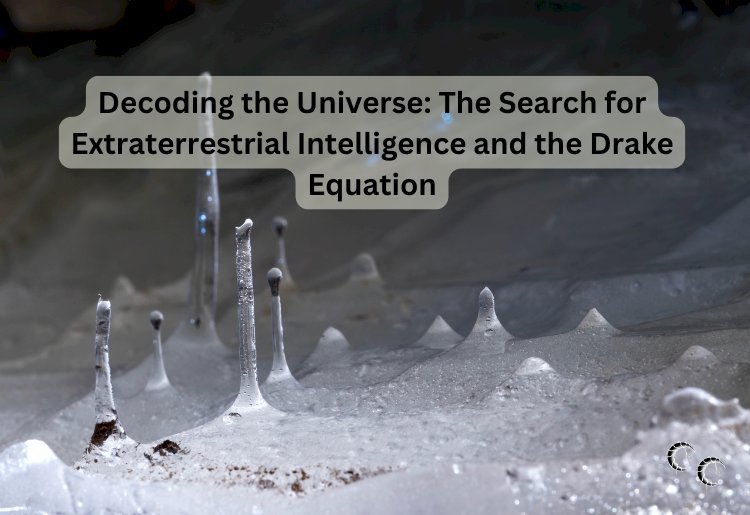Decoding the Universe: The Search for Extraterrestrial Intelligence and the Drake Equation

For as long as humans have gazed at the stars, we’ve wondered: Are we alone in the universe? It’s a question that has fascinated scientists, philosophers, and dreamers alike for centuries. As technology advances, we now have the tools to explore this mystery in greater depth. One of the key frameworks in the search for extraterrestrial intelligence (SETI) is the Drake Equation, a formula that aims to estimate the number of advanced civilizations in our galaxy that could potentially communicate with us.
But the journey to decode the universe and uncover other forms of intelligent life is no simple feat. Let’s take a closer look at what the Drake Equation is, how it came about, and its implications in the search for extraterrestrial intelligence.
The Origins of the Drake Equation
The Drake Equation was first formulated in 1961 by Dr. Frank Drake, an American astronomer and astrophysicist, in an effort to stimulate scientific dialogue about the possibilities of intelligent life beyond Earth. At the time, Dr. Drake was preparing for the first scientific meeting of SETI researchers at the National Radio Astronomy Observatory in West Virginia. He sought to provide a systematic way of addressing a fundamental question: How many civilizations in our galaxy might be capable of communication?
The equation itself is deceptively simple:
N = R × fp × ne × fl × fi × fc × L*
Where:
- N is the number of civilizations with which humans could potentially communicate in our galaxy.
- R* is the rate of star formation in the galaxy.
- fp is the fraction of stars that have planets.
- ne is the number of planets that could potentially support life.
- fl is the fraction of planets where life actually develops.
- fi is the fraction of life forms that evolve into intelligent beings.
- fc is the fraction of civilizations that develop technology that can be detected.
- L is the lifespan of these civilizations.
Each term in the equation represents a crucial factor in determining the likelihood of discovering other intelligent life. However, there’s a catch: many of these factors are still largely unknown, which is why estimates for N can vary dramatically.
The Mystery of the Variables
One of the challenges of the Drake Equation is the uncertainty surrounding its variables. For instance, R*—the rate of star formation—is relatively well understood, thanks to advances in astrophysics. However, fp, the fraction of stars that have planets, wasn’t fully understood until recently, with the discovery of exoplanets—planets outside of our solar system. With thousands of exoplanets now confirmed, it’s clear that planetary systems are common, which makes the prospect of finding habitable planets more plausible.
On the other hand, factors like fl (the emergence of life) and fi (the development of intelligent life) are still filled with uncertainty. We have no clear understanding of how life first began on Earth or how rare the conditions for intelligent life are. This lack of knowledge makes these terms highly speculative and challenging to estimate.
The factor L, the lifespan of civilizations, is perhaps the most daunting. If intelligent civilizations do exist, how long can they survive? We can only speculate, but one of the central questions in astrobiology is whether technological civilizations, including our own, can avoid self-destruction. Whether a civilization can endure for millions or even billions of years is unknown, but it plays a significant role in determining the number of detectable civilizations.
The Search for Extraterrestrial Intelligence (SETI)
In parallel with the development of the Drake Equation, the scientific search for extraterrestrial intelligence has continued to evolve. The SETI program, which uses radio telescopes to listen for signals from distant civilizations, is one of the most well-known initiatives in this field. The idea is that advanced civilizations may be emitting signals into space, much as we send radio waves, television signals, and other forms of communication to the stars.
SETI scientists have scanned the skies for decades, looking for anything that might be a sign of intelligent life—whether it be unusual radio signals, patterns, or technological signatures that could suggest alien civilizations. So far, no confirmed extraterrestrial signals have been detected, but the search continues with ever more sophisticated tools and technologies.
Moreover, the discovery of extremophiles—organisms that can survive in harsh environments—has expanded our understanding of where life might exist beyond Earth. This broadens the search for life to include planets and moons with extreme conditions, such as Mars, Europa (a moon of Jupiter), and Enceladus (a moon of Saturn), which could potentially harbor microbial life.
The Implications of the Drake Equation and the Search for Life
While the Drake Equation may seem abstract or speculative, it has had profound implications for science and our worldview. It encourages us to think about our place in the cosmos and how we might communicate with other intelligent beings. It also serves as a reminder that humanity is just one small part of the vast universe.
The search for extraterrestrial intelligence forces us to confront some of the biggest questions in science, philosophy, and human existence: Are we alone? How common is life in the universe? If intelligent civilizations exist, what are they like? Will we ever make contact?
As technology improves, we may find more answers to these questions. The discovery of even microbial life elsewhere in the solar system or the detection of alien signals would revolutionize our understanding of life in the universe. But even if we don’t find extraterrestrial intelligence in the near future, the pursuit itself is valuable—expanding our knowledge, sparking innovation, and deepening our sense of wonder.
The Future of the Drake Equation
Despite the unknowns, the Drake Equation remains a guiding tool for thinking about the possibilities of extraterrestrial life. As we continue to refine our understanding of the variables, such as the number of exoplanets that could support life, we might find ourselves closer to answering the age-old question: Are we alone?
Until then, the search for extraterrestrial intelligence will continue, and the Drake Equation will remain a key framework in guiding that quest. Whether we find life beyond Earth or not, the equation symbolizes humanity’s deep desire to explore the unknown and our ever-growing curiosity about the cosmos.
So, as we continue to decode the universe, the quest for answers will always inspire us to look up, wonder, and imagine.





























